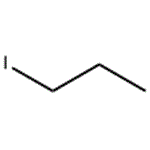- 1-Iodopropane
-

- $1.10 / 1g
-
2023-07-27
- CAS:107-08-4
- Min. Order: 1g
- Purity: 99.0% Min
- Supply Ability: 100 Tons
- 1-Iodopropane 99%
-

- $15.00 / 1KG
-
2021-07-02
- CAS:107-08-4
- Min. Order: 1KG
- Purity: 99%+ HPLC
- Supply Ability: Monthly supply of 1 ton
- 1-Iodopropane
-

- $1.00 / 1KG
-
2020-01-13
- CAS:107-08-4
- Min. Order: 1KG
- Purity: 98%-99.9%
- Supply Ability: 200kg
|
| | 1-Iodopropane Basic information |
| | 1-Iodopropane Chemical Properties |
| Melting point | -101 °C | | Boiling point | 101-102 °C(lit.) | | density | 1.743 g/mL at 25 °C(lit.) | | vapor pressure | 43 mm Hg ( 25 °C) | | refractive index | n20/D 1.504(lit.) | | Fp | 112 °F | | storage temp. | Store below +30°C. | | solubility | 1.1g/l | | form | Liquid | | color | Clear colorless to yellow | | Water Solubility | Fully miscible in water. | | Sensitive | Light Sensitive | | Merck | 14,7862 | | BRN | 505937 | | Henry's Law Constant | (x 10-3 atm?m3/mol):
9.09 at 25 °C (Hine and Mookerjee, 1975) | | Dielectric constant | 7.0899999999999999 | | Stability: | Stable, but may discolour on exposure to light. Incompatible with strong oxidizing agents, strong bases. Flammable. | | CAS DataBase Reference | 107-08-4(CAS DataBase Reference) | | NIST Chemistry Reference | Propane, 1-iodo-(107-08-4) | | EPA Substance Registry System | Propane, 1-iodo- (107-08-4) |
| Hazard Codes | Xn,Xi,N | | Risk Statements | 10-20-36/37/38-52/53-2017/10/20 | | Safety Statements | 16-26-36/37-61 | | RIDADR | UN 2392 3/PG 3 | | WGK Germany | 3 | | RTECS | TZ4100000 | | F | 8 | | Hazard Note | Irritant | | TSCA | Yes | | HazardClass | 3 | | PackingGroup | III | | HS Code | 29033080 | | Toxicity | LD50 (inhalation) for rats 73,000 mg/m3/30-min (quoted, RTECS, 1985). |
| | 1-Iodopropane Usage And Synthesis |
| Chemical Properties | colourless liquid | | Physical properties | Clear, colorless liquid with a characteristic sharp, penetrating odor. On exposure to light, 1-
iodopropane may become pale yellow. | | Uses | 1-Iodopropane is used in wide range of medicals industrial applications as well as in human and animal nutrition products, pharmaceutical intermediates, polarizing films for Liquid Crystal Display (LCD) chemicals. Iodine derivatives are also used as organic building blocks, analytical reagents etc. It is also used as a solvent and intermediate of organic synthesis. | | Synthesis Reference(s) | Tetrahedron Letters, 8, p. 4131, 1967 DOI: 10.1016/S0040-4039(01)89706-9 | | Environmental fate | Biological. A strain of Acinetobacter sp. isolated from activated sludge degraded 1-iodopropane
to 1-propanol and iodide ions (Janssen et al., 1987).
Chemical/Physical. Slowly hydrolyzes in water forming 1-propanol and hydroiodic acid. | | Purification Methods | It should be distilled first under reduced pressure to avoid decomposition. Dry the iodide with MgSO4 or silica gel and fractionally distil it. Store it under nitrogen with mercury in a brown bottle. Prior to distillation, free iodine can be removed by shaking with copper powder or by washing with aqueous Na2S2O3 and drying. Alternatively, the n-propyl iodide can be treated with bromine, then washed with aqueous Na2S2O3, dried and distilled. See also n-butyl iodide. [Beilstein 1 IV 222.] |
| | 1-Iodopropane Preparation Products And Raw materials |
|